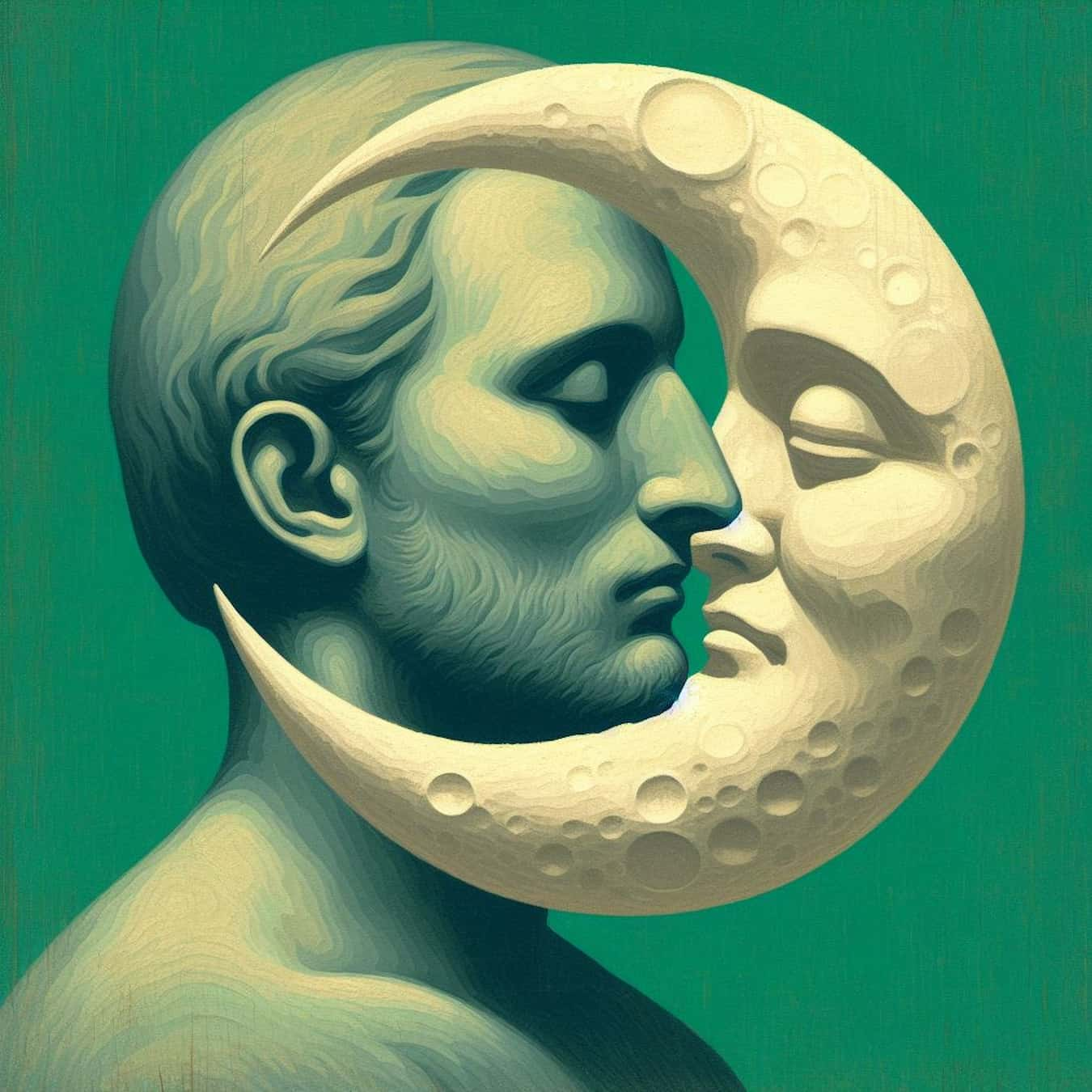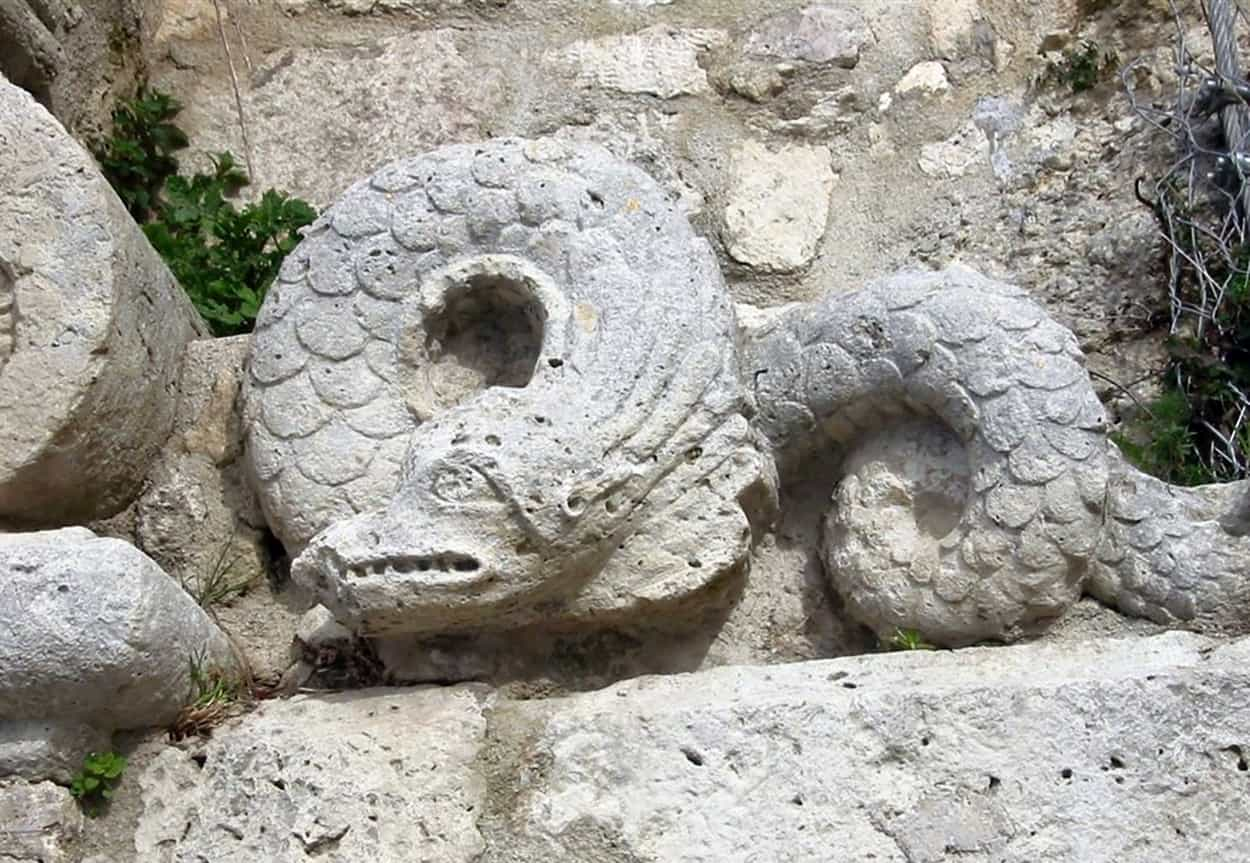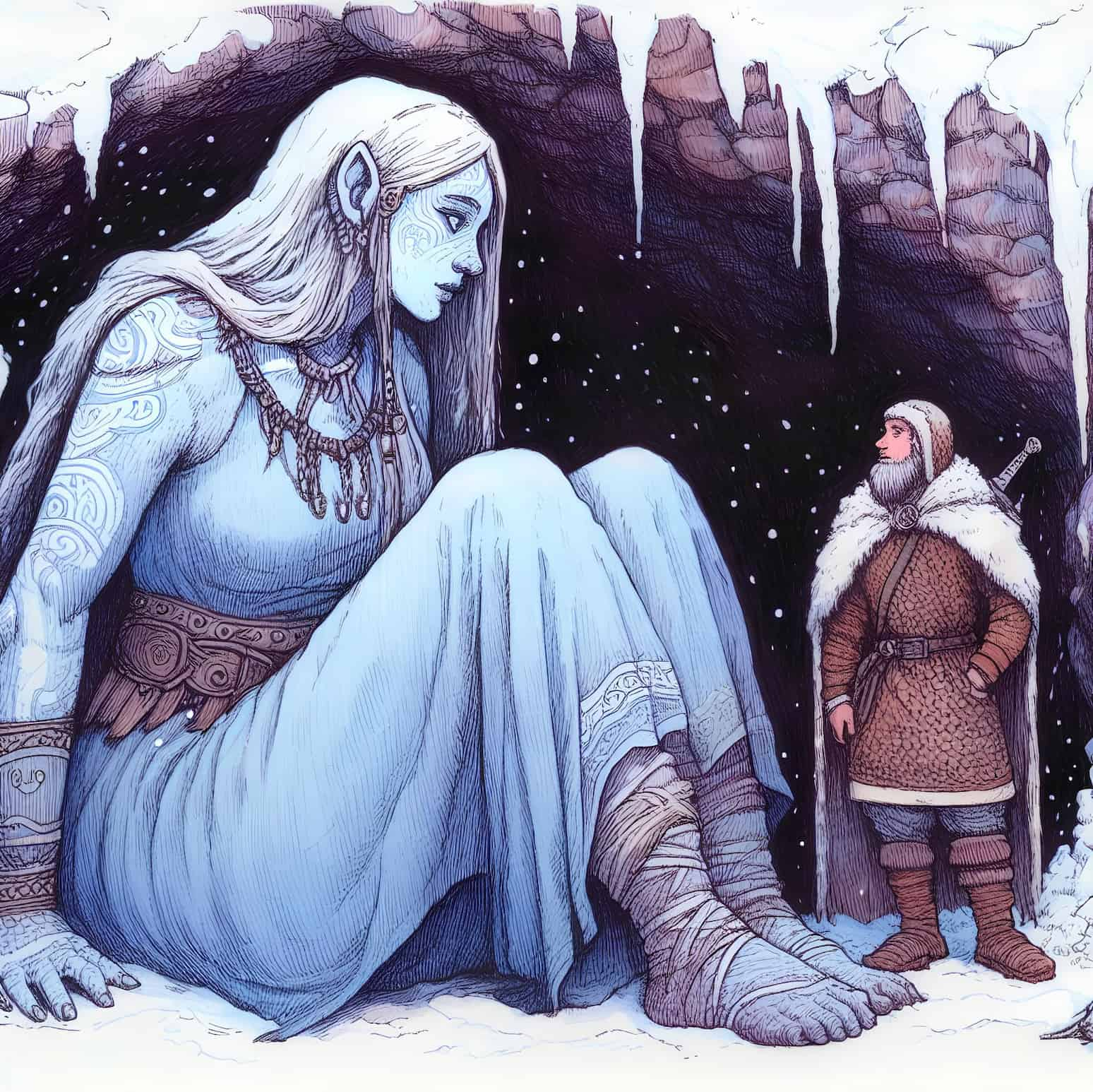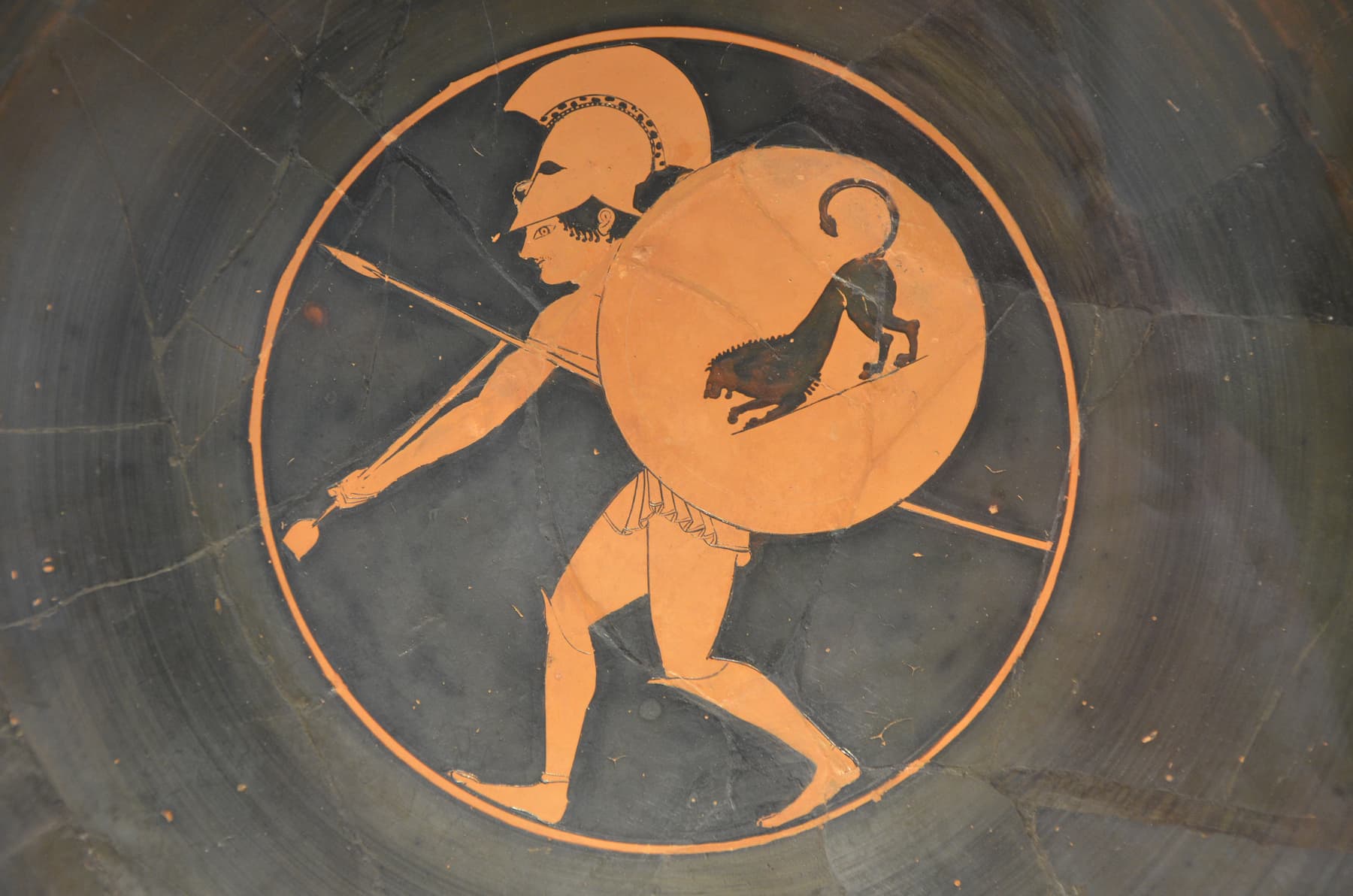The term “Man in the Moon” is a common reference to a pareidolic figure resembling a human face, which is easily visible on the surface of the Moon from Earth, especially during the full moon, particularly from the northern hemisphere. Besides human faces, it’s also possible to discern a whole human figure or even an animal, such as a rabbit, on the surface of the Moon. In many cultures, there are folk traditions, myths, or legends associated with the figures visible on the Moon. In reality, these figures are formed by the extensive dark areas on the Moon’s surface, the so-called lunar seas, surrounded by lighter highland areas.
Origin of the Myth
The concept of Man in the Moon is created as a pareidolia by the shape of some “lunar seas,” the multitude of craters, and the varying strength of reflection or absorption of sunlight (the albedo) of the two types of lunar rock (“lunarite” and “lunar basalt”) during a full moon.
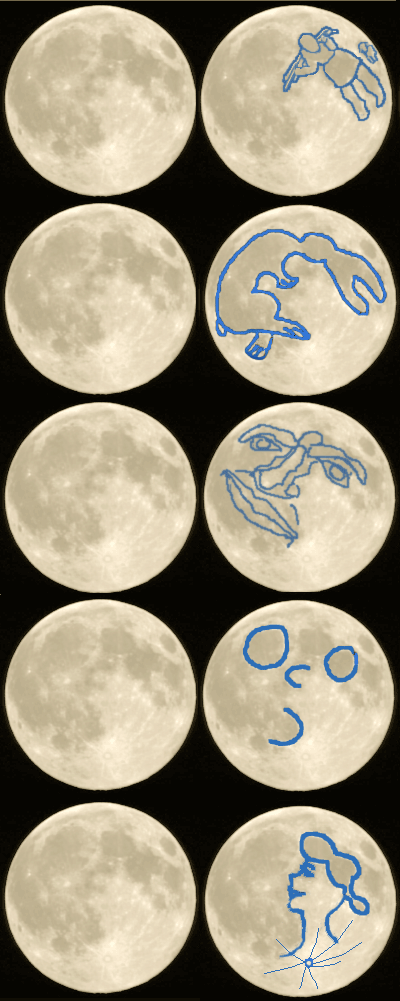
The darker areas evoke associations with a human countenance. In many images, the moon (as well as the sun) is therefore depicted with a face. Symbols for the full moon, half moon, and new moon, for example, often have a face on many watches and calendars; likewise, the moon is heraldry. Sometimes, due to this human-like appearance, the moon was also worshiped as a divine being in ancient cultures.
Structures that can be interpreted as moon faces are visible on one hand during the full moon, when it is illuminated frontally, and on the other hand around the half-moon. Then, terrain structures on the front side of the moon are in sunlight falling obliquely here; sunlit slopes appear bright; shaded areas, on the other hand, appear dark, creating high contrast that outlines other contours, which also change significantly with the age of the moon phase.
These structures are particularly prominent when the crescent moon is narrower than half. With a bit of imagination, a nose, lips with a mouth, and a sea within the fully illuminated crescent can be seen as an eye, and the idea of a profile face is complete. Accordingly, the moon is often depicted as a crescent, at least with a nose, and is immediately recognized as such. Oblique light is especially effective in black-and-white photography as a means to highlight small surface structures in a three-dimensional way.
Figures Seen on the Moon
Man in the Moon
Although the same side of the Moon always faces Earth, it is seen in different orientations from different latitudes and at different times, causing the patterns visible on it to appear tilted in different ways. For example, when viewed from the equatorial regions, it may pass even through the zenith, or at least very close to it, making it appear upside down when it sets compared to how it looked when rising. Therefore, the figures visible on the Moon are not the same everywhere on Earth.
In the northern hemisphere, the Man in the Moon is commonly perceived as having the Sea of Rains (Mare Imbrium) and the Sea of Serenity (Mare Serenitatis) as its eyes, the Bay of Heat (Sinus Aestuum) as its nose, and the Sea of Storms (Oceanus Procellarum) and the Sea of Clouds (Mare Nubium) forming its open mouth. In this way, it can still be perceived as such even at tropical latitudes on both sides of the equator when the Moon rises, but as one moves southward, for a shorter time, and from the South Pole, not at all.
In Western art, the full moon is often depicted simply as a representation of a human face, as the face of the Man in the Moon. Similarly, the waxing crescent is often depicted as a human profile, even though it doesn’t resemble the Moon as it appears in that phase. Similarly, the Moon in its various phases has been depicted in traditional almanacs using symbols representing the lunar phases.
“Man in the Moon” can also refer to a mythological being said to reside on or within the Moon’s surface but is not necessarily associated with the facial features observed on the Moon. One such example is the Chinese mythological figure Yue Lao.
The Stick-Carrying Man
Other figures have also been seen on the Moon, although they only encompass part of the Moon’s visible surface. According to an old tradition, on the eastern side of the Moon, a man carrying a load of sticks on his back has been seen, possibly accompanied by a small dog.
In this depiction, the “head” and “torso” of the man are formed by the Seas of Tranquility and Serenity (Mare Tranquillitatis and Mare Serenitatis), his legs are the Sea of Nectar (Mare Nectaris) and the Sea of Fertility (Mare Fecunditatis), while the load of sticks consists of the Sea of Vapors (Mare Vaporum) and the Bay of Heat (Sinus Aestuum) on one side, and on the other side, the Lake of Death (Lacus Mortis) and the Lake of Dreams (Lacus Somniorum). The dog is represented by the Sea of Crises (Mare Crisium).
Woman’s Profile
On the central part of the Moon’s visible side, a woman’s profile has also been observed. In this case, the “head” is formed by the bright areas of the Moon, while the “hair” consists of the dark “seas” of the Moon. The woman’s mouth is Sinus Medii, and her eye is the Sea of Vapors (Mare Vaporum), while the dark hair on the top of her head is formed by the Seas of Serenity (Mare Serenitatis), Tranquility (Mare Tranquillitatis), Nectar (Mare Nectaris), and Fertility (Mare Fecunditatis) together.
Rabbit
During a full moon, a rabbit can also be seen on the Moon, which is a traditional interpretation especially in East Asia. In this depiction, different parts of the rabbit correspond to the following lunar seas:
- head: Sea of Tranquility (Mare Tranquillitatis)
- ears: Sea of Fertility (Mare Fecunditatis) and Sea of Nectar (Mare Nectaris)
- upper body and neck: northern part of the Sea of Storms (Oceanus Procellarum) and the Sea of Vapors (Mare Vaporum)
- lower body: Sea of Storms (Oceanus Procellarum)
- legs: Bay of Dew (Sinus Roris).
The rabbit can also be seen holding a sack; this is the Sea of Rains (Mare Imbrium).
Similar Myths
There are many mythical explanations for the origin of the Man in the Moon and the facial features observed on the Moon.
In Europe, since ancient times, there have been stories suggesting that a man was cursed and banished to the Moon because of a crime. According to one Christian tradition, he was caught gathering sticks on the Sabbath, and thus, according to the regulations in the Book of Numbers, he was stoned to death. In some Germanic cultures, he was believed to have stolen part of his neighbor’s hedge to repair his own. According to a Roman legend, he was a sheep thief.
According to a medieval Christian tale, the man was Cain, a wanderer and fugitive who was condemned to wander the Earth forever. This is referred to, among other places, in Dante’s Divine Comedy, first in the 20th canto of the Inferno and again in the 2nd canto of the Paradise. The Talmud also contains a tradition that Jacob’s facial features were carved on the Moon, although this is not mentioned in the Bible.
In Norse mythology, Máni is the personification of the Moon, who travels across the sky in a chariot pulled by horses. He is constantly pursued by the Great Wolf Hati, who catches him at Ragnarök. The name Máni simply means Moon. In Chinese mythology, the goddess Chang’e drifted to the Moon after foolishly consuming a double dose of immortality potion. She is followed by a small group of Moon rabbits.
In Haida mythology, there is a boy who collects sticks on the Moon. The boy’s father had told him that there would be bright moonlight at night, which would make the task possible. When the boy refused to perform his task, he complained and laughed at the moon. As punishment for his disrespectful behavior, the boy was taken away from the Earth and imprisoned on the Moon.
The Man in the Moon and other figures seen on the Moon have provided inspiration for many children’s rhymes around the world.
Interpretations
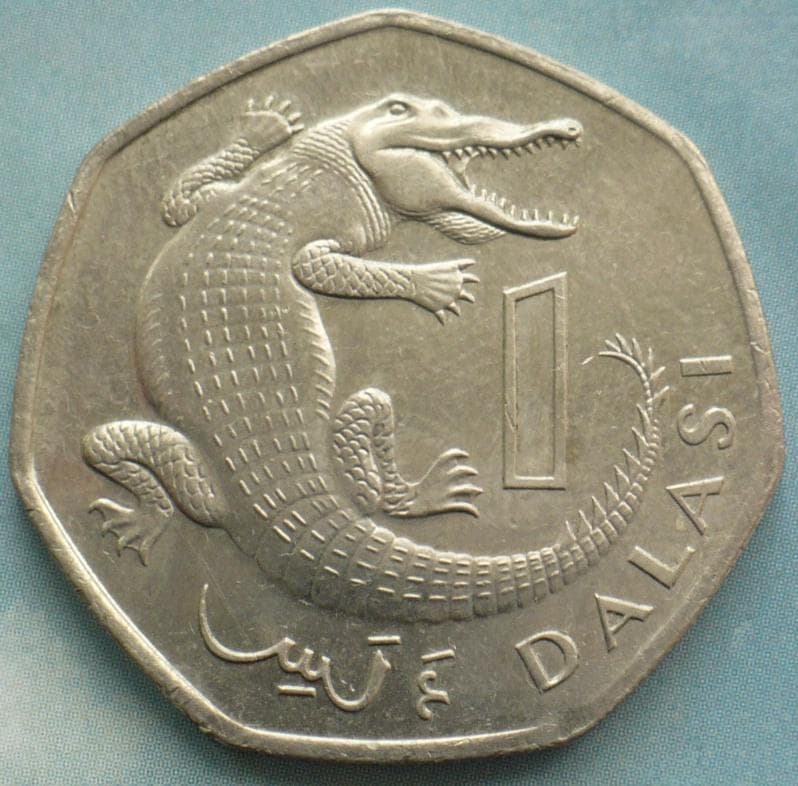
- The interpretation of the lunar surface structure as a man is widespread among speakers of Germanic languages. In addition to the visual interpretation, the similarity or sometimes even identity of the Germanic words for “man” and “moon” also plays a fundamental role. In various fairy tales, this man is seen as a man carrying a bundle of twigs who cut twigs on Sunday and was punished for breaking the Sunday work ban by being sent to the moon for eternity. The oldest version was published in 1803 by Johann Peter Hebel in Allemannische Gedichte. For lovers of rural nature and customs. It was then picked up by many authors, including the Brothers Grimm from 1857 on. The version of The Tale of the Man in the Moon by Ludwig Bechstein from 1853 is well known. Another version can be found in Peterchens Mondfahrt.
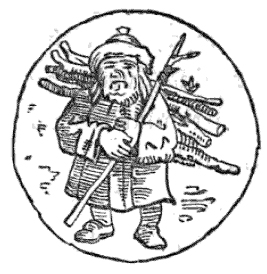
- In Norse mythology, Bil and Hiuki are seen on the moon with a bucket and a pole.
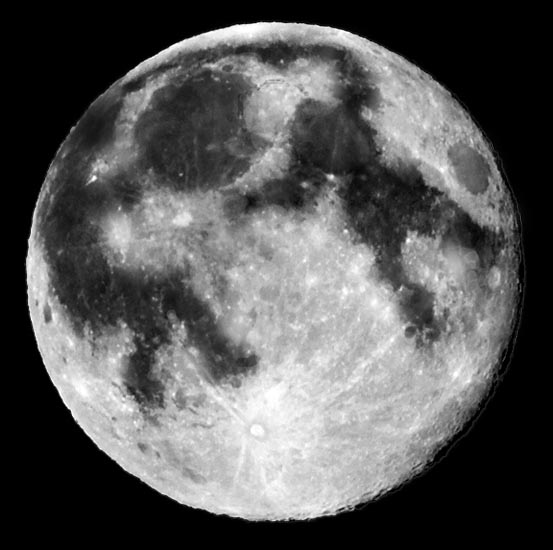
- The “rabbit in the moon” is a common image used throughout East Asia, recognized in the moon – compare “Jade Rabbit (Yutu)” in China, “Tsuki no Usagi” in Japan, “Dal Tokki” in Korea, etc. A similar image exists in several pre-Columbian Mesoamerican cultures, such as the Aztecs. However, they saw a rabbit on the moon, as is also evident in some Aztec names.
- In contrast, the West Africans from Gambia see a “crocodile in the moon.” The upper and lower jaws correspond to the rabbit ears of the Asian interpretation.
- In South Africa, on the other hand, a woman carrying firewood on her back is seen on the moon.
- Some philosophers of antiquity believed that the face of the earth is reflected in the moon. They considered the prevailing bright areas to be the reflection of the highly reflective oceans and the dark spots to be a reflection of the earthly lands.
- Other scholars of antiquity, such as the writer Plutarch in his work On the Face of the Moon, and also of the Renaissance, such as the astronomer Johannes Kepler, believed, however, that the darker spots on the moon were the lunar seas.
The Man in the Moon in Literature and Music
The Man in the Moon plays a role especially in poems and songs for children. In addition, the personification of the moon has been taken up by many serious poets. The figure of the moon is mostly positively portrayed. An exception is Peterchens Mondfahrt.
- A popular chant, symbolically accompanied by a finger: “Dot, dot, comma, line—finished is the Man in the Moon.”
- The Man in the Moon, children’s and youth literature by Gerda Marie Scheidl, exists in Japanese (Marion-no-otsukisama), Slovenian (Luncek), Dutch (Het maanportret), Finnish (Paperikuu), and Danish (Måneansigtet).
- Man in the Moon, stories by Jack London.
- Frau Luna, operetta by Paul Lincke, premiered in 1899 in Berlin.
- Goethe writes in West-östlicher Divan in the poem “Nachklang”:
Don’t leave me to the night, the pain,
You dearest, you my moon face!
O you my phosphorus, my candle,
You my sun, you my light!
Song titles with names “Moon Face” or “Man in the Moon” are sung by the following artists:
- Fettes Brot – Superman and Moon Face from the album Outside Top Hits, inside Taste
- Andy Knote on the album Arts of Toyco / Anime Hits
- Detlev Jöcker – I know a little moon face from the album For Sweet Dreams
- Engelbert sang the title “It’s only me and you under the man in the moon”
- Heino Gaze’s hit “La-Le-Lu, only the man in the moon is watching”
- The singer Gus Backus had the title “Man on the Moon” even twice, once in 1961 at the beginning of the Apollo program and once in a revised version after the moon landing in 1969.
- Megaherz – Man on the Moon from the album Götterdämmerung
- Die Prinzen sing Man on the Moon on the album “Life is cruel”
- R.E.M. – Man on the Moon from the album Automatic for the People
- Unheilig – Man on the Moon from the album The 2nd Commandment
- Markus and Nena: Kleine Taschenlampe brenn’ interprets the idea of a man in the moon.
- IC Falkenberg – Man on the Moon on the album “Dream Archive”
- Audio88, Yassin, Döll, Mädness – Man on the Moon on the album “Normal Samt”
The Man in the Moon in Film and Television
- A Trip to the Moon (original title: Le Voyage dans la Lune) by Georges Méliès from 1902; one of the most famous scenes in science fiction depicts the Man in the Moon.
- The Man in the Moon (film) by Robert Mulligan from 1991.
- The Man on the Moon (1999) by Miloš Forman about Andy Kaufman.
- Mondmann by Fritz Böhm from 2007; short and children’s film in which the moon man appears as an actor.
- The Man in the Moon (2012).
In the film Rise of the Guardians, the Man in the Moon is a higher being who chooses the title Guardians of Light.
Scientific Explanation
The Man in the Moon and other figures seen on the Moon consist of the so-called lunar seas. As there are several pareidolic figures seen on the Moon, different figures are composed of different seas. The vast, flat areas of the Moon are called “seas” (Latin: mare, plural maria) because astronomers of old believed them to be extensive bodies of water. However, it is now known that they do not contain water; instead, they are large areas covered by basalt, formed when lava seeped out from within the Moon into a large impact crater and then solidified.
The same side of the Moon always faces towards Earth, and naturally, all those seas from which the features of the Man in the Moon are formed are on that side. The rotation of the Moon is tidally locked. Due to the gravitational forces caused by the Moon’s oblong shape, its rotational motion has slowed to the point where it rotates around its axis only once at exactly the same time it orbits the Earth. Therefore, the same side of the Moon always faces towards Earth, and on this side, naturally, are also all those seas from which the features of the “Man in the Moon” are formed.


